From Restless to Refreshed: 10 Best Bedroom Plants for Better Sleep

Are you struggling with sleepless nights?
Your bedroom might be missing some green allies.
Plants can transform your sleep space from restless to refreshing.
In this guide I’ll reveal the 10 best bedroom plants to enhance your sleep.
We’ll explore how these leafy companions purify air, reduce stress, and promote relaxation.
From low-maintenance options to aromatherapy powerhouses, there’s a plant for everyone’s need.
Get ready to wake up the feeling of revitalized and energized with these plant-powered sleep solutions.
The Science Behind Plants and Sleep
Plants do more than beautify your bedroom; they actively contribute to better sleep proven through scientific processes.
Research shows that certain plants can significantly improve sleep quality by altering the bedroom environment.
These green sleep aids work through various mechanisms, including air purification, aromatherapy, and psychological effects.
Understanding these scientific principles can help you choose the most effective plants for your sleep sanctuary.
Air purification properties
Plants actively remove toxins and pollutants from your bedroom air.
Many species absorb harmful substances like formaldehyde, benzene, and trichloroethylene during the night.
This process creates a cleaner, more oxygen-rich environment conducive to better sleep.
Aromatherapy benefits
Certain plants offer natural scents that directly impact sleep quality.
Their aromas can reduce stress, anxiety, and promote relaxation.
Lavender, for example, lowers heart rate and blood pressure, preparing your body for rest.
Plant-based fragrances stimulate the production of sleep-inducing hormones like melatonin.
Psychological effects of greenery in the bedroom
The presence of plants in the bedroom has positive psychological impacts.
The greenery creates a sense of tranquility and connection to nature.
This biophilic element reduces stress and promotes a calm state of mind.
Viewing plants before sleep can lower cortisol levels and increase feelings of well-being.
Plant care can be a meditative act, further enhancing pre-bedtime relaxation.
Top 10 Best Bedroom Plants for Better Sleep
1. Lavender
Lavender is a top choice for better sleep due to its potent aromatherapeutic properties.
This purple beauty not only adds a touch of elegance to your bedroom but also serves as a natural sleep aid.
- Sleep-inducing properties: Lavender’s scent reduces anxiety and promotes relaxation. It lowers heart rate and blood pressure, preparing your body for sleep. The plant’s aroma increases slow-wave sleep, crucial for muscle relaxation and recovery. Lavender also lengthens total sleep time, helping you wake up more refreshed.
- Care instructions: Lavender thrives in bright, direct sunlight. Water the plant when the top inch of soil feels dry. Use well-draining soil to prevent root rot. Prune regularly to maintain shape and encourage new growth. Fertilize monthly during the growing season for optimal health.
- Ideal placement in the bedroom: Place lavender on a sunny windowsill or bedside table. Keep it within arm’s reach to easily brush the leaves before bed. Ensure good air circulation around the plant to prevent mold. Consider using a small fan to distribute the scent evenly across the room.
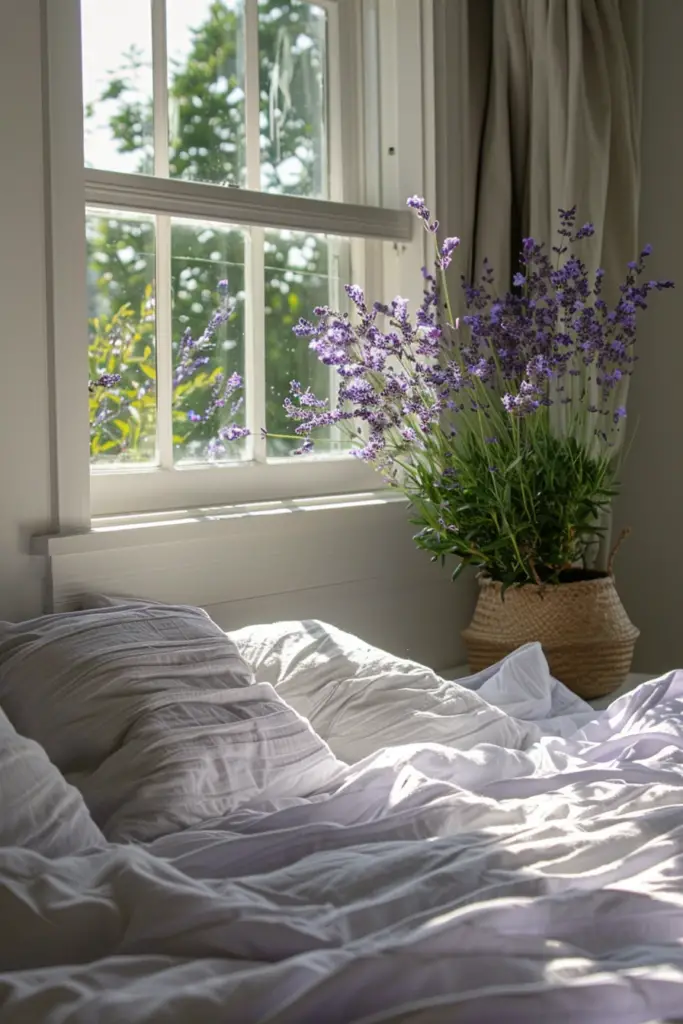
2 Snake Plant (Sansevieria)
The Snake Plant, also known as Mother-in-Law’s Tongue, is a powerhouse of air purification and low-maintenance care.
This resilient plant thrives in bedroom environments and offers multiple benefits for better sleep.
- Air-purifying qualities: Snake Plants excel at filtering indoor air pollutants. They remove toxins like formaldehyde, benzene, and trichloroethylene from the air. Unlike most plants, Snake Plants release oxygen at night, improving air quality as you sleep. This nighttime oxygen boost can lead to more restful sleep and increased energy upon waking.
- Low maintenance benefits: Snake Plants are incredibly forgiving and easy to care for. They tolerate low light conditions and irregular watering schedules. These plants can survive weeks without water, making them ideal for busy individuals or frequent travelers. Snake Plants resist most pests and diseases, reducing the need for chemical treatments in your bedroom.
- Best varieties for bedrooms: Sansevieria trifasciata ‘Laurentii’ features striking yellow leaf margins. The compact Sansevieria ‘Hahnii’ is perfect for small spaces or nightstands. Sansevieria cylindrica, with its unique cylindrical leaves, adds a modern touch to bedroom decor. Consider the variegated Sansevieria ‘Moonshine’ for a softer, silvery appearance that complements various color schemes.
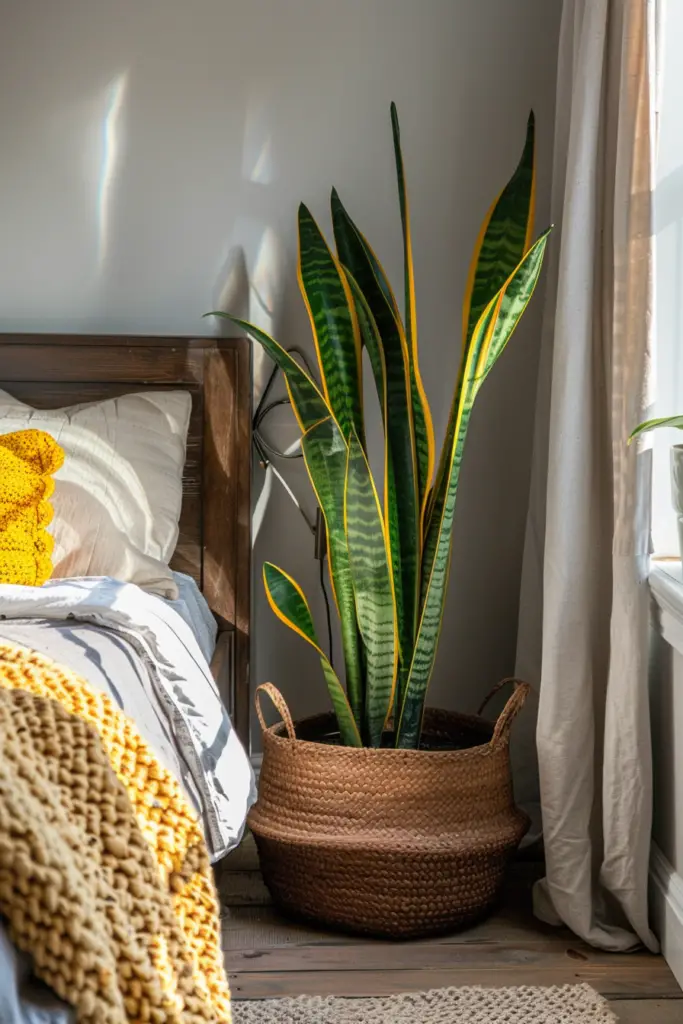
3. Jasmine
Jasmine, with its sweet and captivating fragrance, is a powerful ally for improving sleep quality.
This elegant plant not only beautifies your bedroom but also offers significant sleep-enhancing benefits.
Scent’s impact on sleep quality: Jasmine’s aroma reduces anxiety and promotes relaxation. Studies show it improves sleep efficiency and increases daytime alertness. The scent lowers the heart rate and decreases restlessness during sleep. Jasmine’s fragrance stimulates the production of GABA, a sleep-regulating neurotransmitter.
Growing and care tips: Jasmine thrives in bright, indirect sunlight. Water the plant when the top inch of soil feels dry. Use well-draining soil to prevent root rot. Prune regularly to maintain shape and encourage blooming. Fertilize monthly during the growing season with a balanced, water-soluble fertilizer.
Optimal positioning for aromatherapy effects: Place jasmine near your bed or on a nightstand for maximum benefit. Consider hanging the plant in a basket near your headboard. Ensure good air circulation to spread the scent throughout the room. Position jasmine near a slightly open window to allow its fragrance to mingle with fresh air.
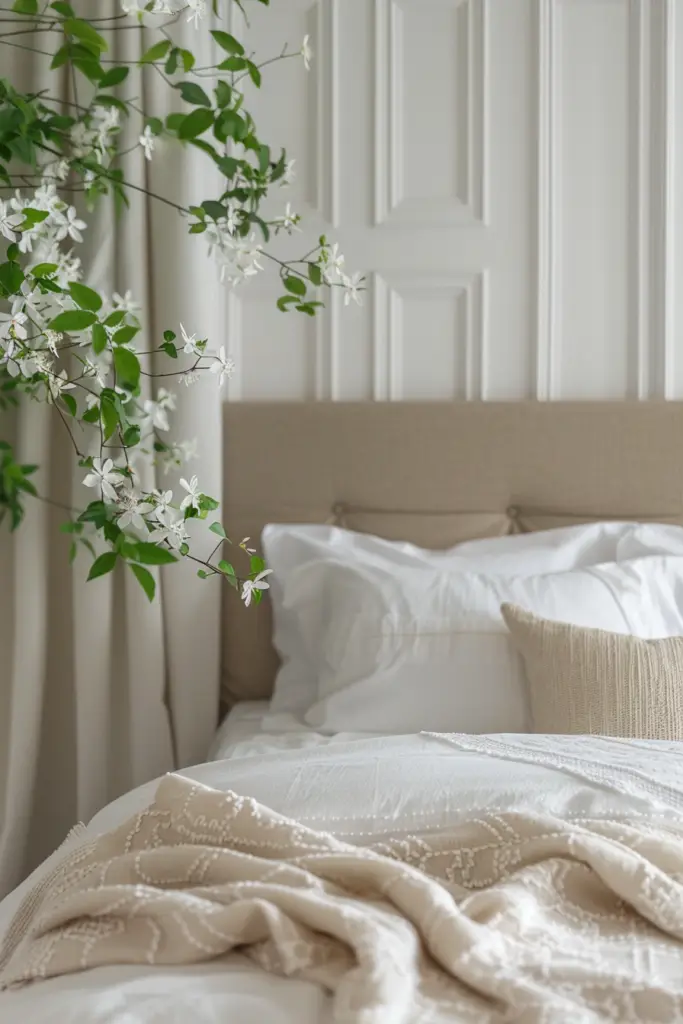
4. Aloe Vera
Aloe Vera, known for its healing properties, also serves as an excellent bedroom plant.
This succulent offers multiple benefits that contribute to better sleep and overall health.
- Oxygen production at night: Aloe Vera releases oxygen during the night, improving air quality. This nocturnal oxygen boost can enhance sleep quality and depth. The plant also absorbs carbon dioxide, creating a fresher sleeping environment. Its oxygen production complements the body’s natural circadian rhythm.
- Additional health benefits: Aloe Vera purifies air by removing formaldehyde and benzene. The plant’s gel soothes minor burns and skin irritations. Its presence can reduce stress and promote a sense of well-being. Aloe Vera improves indoor humidity, benefiting respiratory health during sleep.
- Care requirements: Aloe Vera thrives in bright, indirect sunlight. Water the plant deeply but infrequently, allowing the soil to dry between waterings. Use well-draining cactus or succulent soil to prevent root rot. Place in a pot with drainage holes to avoid water accumulation. Fertilize sparingly, only during the growing season, with a balanced, water-soluble fertilizer.
5. English Ivy
English Ivy is a versatile and attractive plant that offers significant benefits for bedroom air quality.
This climbing vine not only adds a touch of nature to your sleep space but also contributes to a healthier sleep environment.
- Allergen-reducing capabilities: English Ivy effectively filters airborne mold particles. It removes up to 94% of airborne feces and 78% of airborne mold in just 12 hours. The plant absorbs formaldehyde, improving overall air quality. Its allergen-reducing properties can lead to easier breathing and better sleep.
- Ideal growing conditions: English Ivy prefers bright, indirect light but tolerates low light conditions. Water the plant when the top inch of soil feels dry. Maintain moderate humidity levels for optimal growth. Use well-draining potting soil to prevent root rot. Keep temperatures between 50-70°F (10-21°C) for best results.
- Creative display ideas: Hang English Ivy on a floating shelf above your bed. Train the vines to climb a trellis or wire frame near a window. Create a living wall with multiple ivy plants for a dramatic effect. Use ivy in a hanging basket to save floor space in small bedrooms. Incorporate ivy into a bedside table arrangement for easy access to its air-purifying benefits.
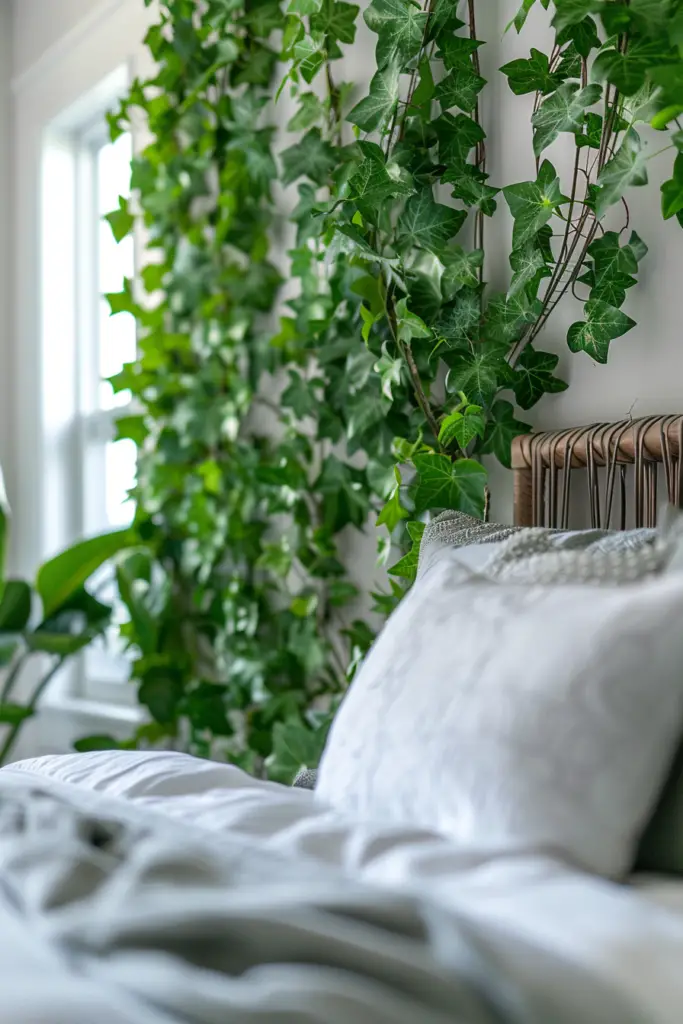
6. Valerian
Valerian is a powerful sleep-inducing plant that doubles as a natural remedy for insomnia.
This herb’s unique properties make it an excellent addition to any bedroom aimed at improving sleep quality.
- Natural sedative properties: Valerian root contains compounds that promote relaxation and sleep. Its scent increases GABA levels in the brain, reducing anxiety and restlessness. Studies show valerian can improve sleep latency and quality. The plant’s calming effects may help regulate sleep-wake cycles over time.
- Cultivation techniques: Valerian thrives in full sun to partial shade conditions. Plant in well-draining, fertile soil rich in organic matter. Water regularly, keeping the soil moist but not waterlogged. Prune flower stalks after blooming to encourage bushier growth. Harvest roots in the fall of the second or third year for maximum potency.
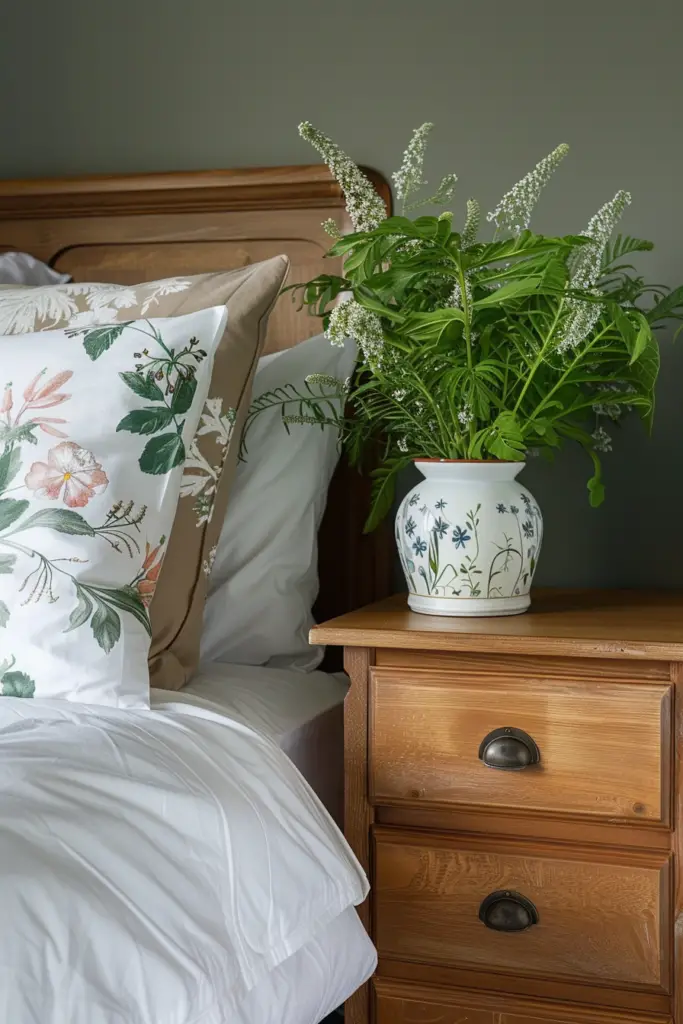
7. Peace Lily
Peace Lilies are elegant plants that offer multiple benefits for a sleep-friendly bedroom.
These versatile plants improve air quality and humidity while requiring minimal care.
- Humidity-increasing properties: Peace Lilies naturally increase room humidity through transpiration. Higher humidity levels can reduce snoring and ease respiratory issues. The plant’s moisture output helps prevent dry skin and irritated sinuses. Improved humidity contributes to more comfortable and restful sleep.
- Air-purifying benefits: Peace Lilies excel at removing common indoor pollutants. They filter out benzene, formaldehyde, and trichloroethylene. The plant can absorb and neutralize toxic molds in the air. Its air-cleaning abilities contribute to a healthier sleep environment.
- Care and maintenance tips: Peace Lilies thrive in low to medium indirect light. Water when the top inch of soil feels dry to the touch. Use well-draining potting soil to prevent root rot. Wipe leaves occasionally to remove dust and maintain their air-purifying efficiency. Fertilize monthly during the growing season with a balanced, water-soluble fertilizer.
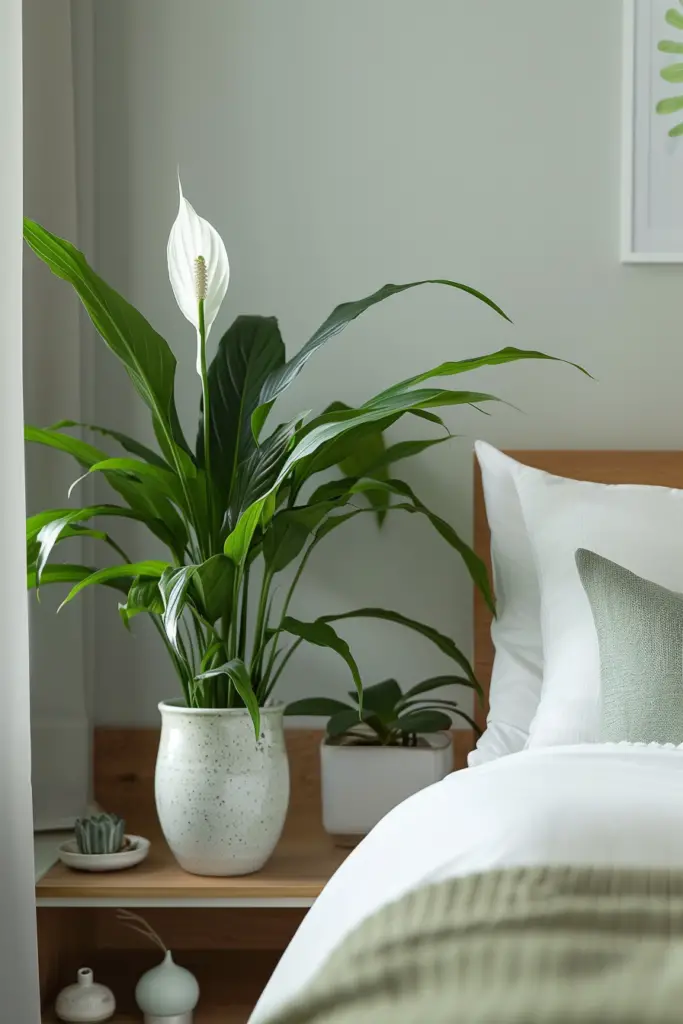
8. Bamboo Palm
Bamboo Palm, also known as Reed Palm, is an excellent choice for improving bedroom air quality.
This tropical plant offers multiple benefits while adding a touch of lush greenery to your sleep space.
- Natural air humidifier: Bamboo Palms release significant moisture into the air through transpiration. This natural humidifying effect helps maintain optimal indoor humidity levels. Higher humidity can alleviate dry skin, sore throats, and respiratory issues during sleep. The plant’s moisture output creates a more comfortable sleeping environment.
- Size considerations for bedrooms: Bamboo Palms can grow up to 7 feet tall, making them suitable for larger bedrooms. Smaller varieties are available for compact spaces or nightstands. Consider the plant’s eventual size when choosing a location in your bedroom. Proper placement ensures the palm doesn’t overcrowd your sleep area.
- Growth and care instructions: Bamboo Palms thrive in bright, indirect light but tolerate lower light conditions. Water when the top inch of soil feels dry, avoiding overwatering. Use well-draining potting soil to prevent root rot. Maintain temperatures between 65-80°F (18-27°C) for optimal growth. Fertilize monthly during the growing season with a balanced, water-soluble fertilizer.
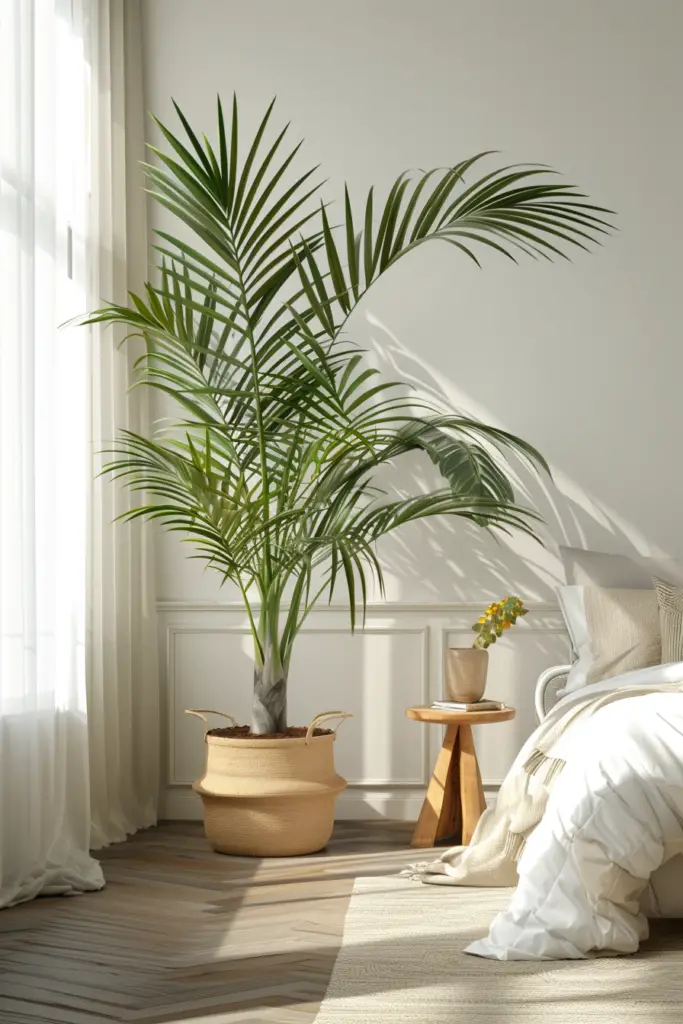
9. Gerbera Daisy
Gerbera Daisies bring a cheerful touch to your bedroom while offering sleep-enhancing benefits.
These vibrant flowers contribute to better air quality and mood improvement.
- Oxygen production at night: Gerbera Daisies continue to release oxygen throughout the night. This nighttime oxygen boost can lead to improved sleep quality. The increased oxygen levels may help reduce sleep apnea symptoms. Better oxygenation can result in feeling more refreshed upon waking.
- Mood-boosting colors: Gerbera Daisies come in a wide range of vivid colors. Their bright hues can elevate mood and reduce stress before bedtime. The flowers’ cheerful appearance may promote positive thoughts before sleep. Color therapy suggests that certain Gerbera shades can influence relaxation and well-being.
- Care and blooming tips: Gerbera Daisies thrive in bright, indirect sunlight. Water the plant when the top inch of soil feels dry. Ensure good air circulation to prevent fungal issues. Remove spent blooms to encourage continuous flowering. Fertilize every two weeks during the growing season with a balanced, water-soluble fertilizer.
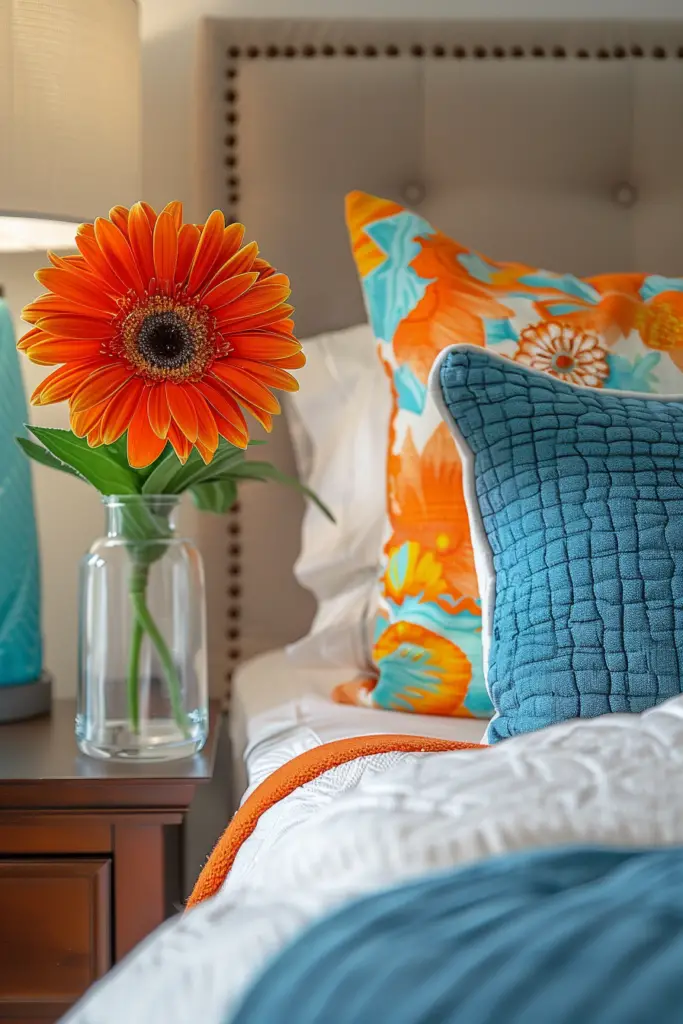
10. Golden Pothos
Golden Pothos, also known as Devil’s Ivy, is a versatile and beneficial plant for bedroom environments.
This hardy vine combines low-maintenance care with powerful air-purifying abilities.
- Easy-care nature: Golden Pothos thrives in various light conditions, from low to bright indirect light. It tolerates irregular watering and can bounce back from neglect. The plant adapts well to different indoor environments and temperatures. Its resilience makes it an ideal choice for plant beginners or busy individuals.
- Air-purifying qualities: Golden Pothos effectively removes indoor air pollutants like formaldehyde and benzene. It continues to purify the air throughout the night, improving sleep quality. The plant’s large leaves increase its air-cleaning efficiency. NASA studies rank Golden Pothos among the top air-purifying houseplants.
- Propagation and growth habits: Golden Pothos grows quickly, forming long, trailing vines. It’s easily propagated from stem cuttings in water or soil. The plant can be trained to climb or left to cascade from shelves or hanging baskets. Regular pruning encourages bushier growth and maintains the desired size. Its rapid growth allows for frequent propagation, enabling multiple plants from one parent.
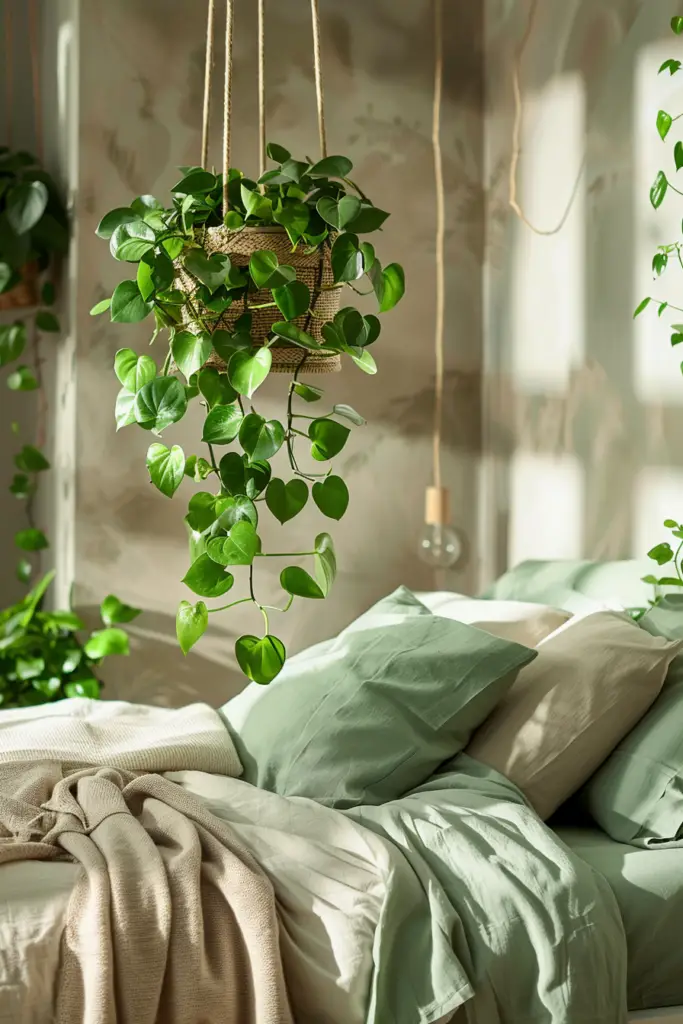
Plant Care Tips for Busy Individuals
Caring for bedroom plants doesn’t have to be time-consuming.
With the right approach, even busy individuals can maintain a thriving indoor garden.
Low-maintenance options:
Choose resilient plants like Snake Plants, ZZ Plants, or Pothos.
These species tolerate neglect and varied light conditions.
Succulents and cacti require minimal watering and care.
Consider self-watering pots to reduce maintenance frequency.
Watering and feeding schedules:
Implement a weekly plant check routine.
Water most plants when the top inch of soil feels dry.
Use a moisture meter for precise watering needs.
Feed plants monthly during growing seasons with a balanced, water-soluble fertilizer.
Set calendar reminders for watering and feeding days.
Common problems and solutions:
Address yellowing leaves by adjusting watering habits or light exposure.
Treat pest infestations early with neem oil or insecticidal soap.
Prune regularly to maintain plant shape and remove dead foliage.
Rotate plants periodically to ensure even growth and light exposure.
Repot plants annually or when roots outgrow current containers.
Potential Concerns and Precautions
While bedroom plants offer numerous benefits, it’s essential to consider potential drawbacks and take necessary precautions.
Allergies and sensitivities:
Some individuals may be allergic to certain plants or their pollen.
Choose hypoallergenic options like Snake Plants or Spider Plants for sensitive individuals.
Regularly clean plant leaves to reduce dust accumulation.
Consider air-purifying plants that don’t produce pollen or strong scents.
Consult an allergist if you experience persistent symptoms around plants.
Pet-friendly options:
Many common houseplants can be toxic to pets if ingested.
Opt for pet-safe plants like Spider Plants, Boston Ferns, or Areca Palms.
Keep plants out of reach of curious pets using hanging baskets or high shelves.
Research plant toxicity before bringing new species into pet-friendly homes.
Contact a veterinarian immediately if you suspect plant ingestion by pets.
Avoiding over-cluttering the bedroom:
Limit the number of plants to maintain a balanced, uncluttered space.
Choose multi-functional plants that offer both aesthetics and air-purifying benefits.
Utilize vertical space with wall-mounted planters or hanging baskets.
Group plants strategically to create a focal point without overwhelming the room.
Regularly assess and rotate plants to maintain an organized bedroom environment.
Conclusion
Bedroom plants offer proven benefits for better sleep.
Lavender, snake plant, jasmine, aloe vera, and peace lily top of the list for their sleep-enhancing properties.
Choose plants that match your care capabilities and bedroom conditions.
Experiment with different combinations to create your ideal sleep environment.
Remember, the right plants can transform your bedroom into a natural sleep sanctuary.
Start your green sleep journey today and experience the difference firsthand.
- 16 Funky Living Room Ideas to Bring Colors, Fun & Personality to Your Space - November 9, 2025
- 12 Small Bathroom Ideas on a Budget That Make Your Space Look Bigger & Stylish - November 6, 2025
- 20 Modern Boho Living Room Ideas That Are Cozy & Absolutely Stunning - November 2, 2025
